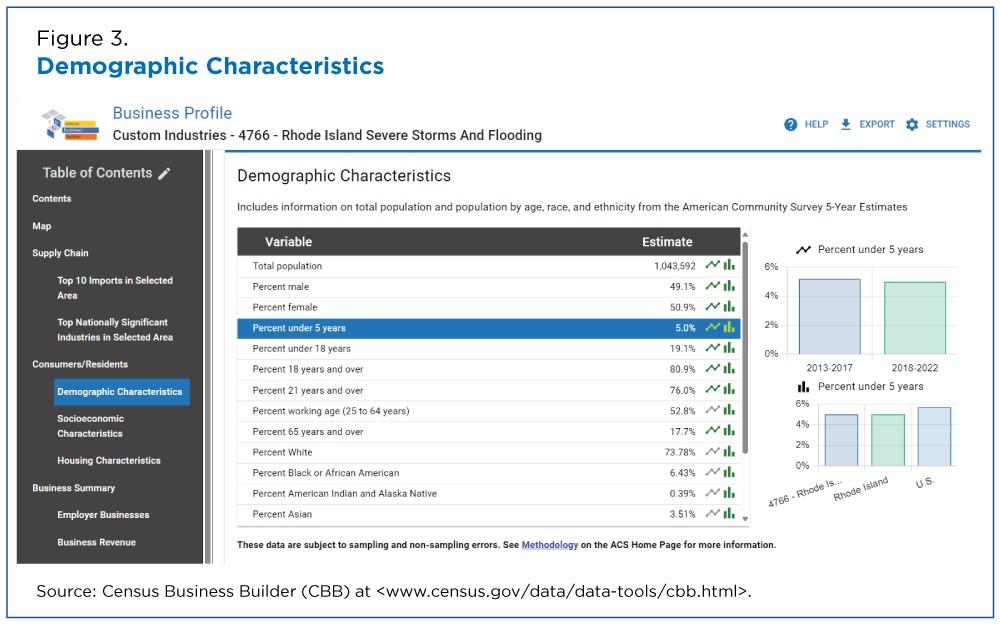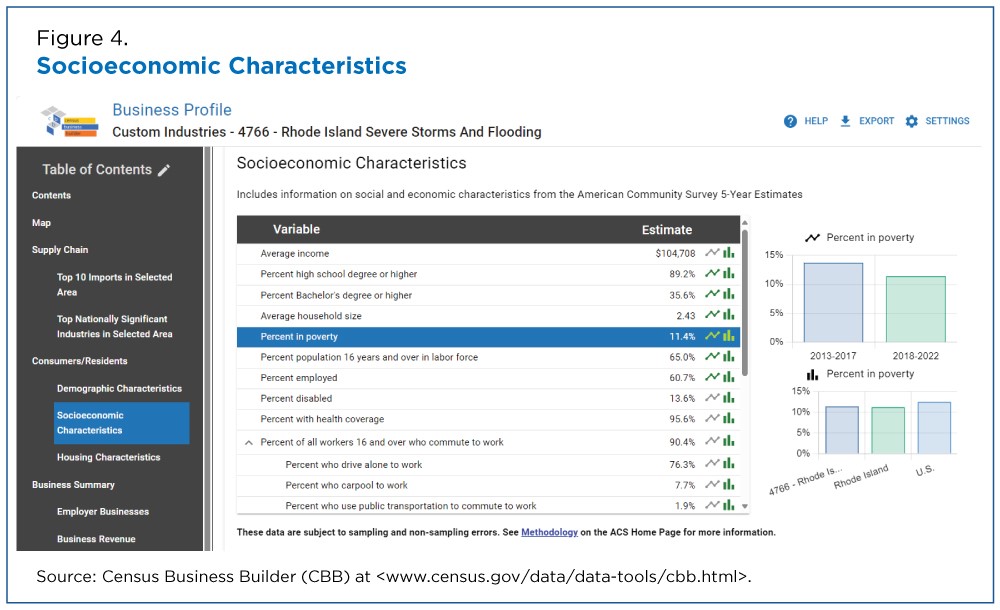Census Business Builder (CBB) Provides a Detailed Picture of Economic Sectors and Populations Affected by Disasters
On January 9, 2024, a major storm system hit Rhode Island, prompting a federal disaster declaration in four counties in the state. Rhode Island was officially classified as a FEMA Declared Disaster on March 20, 2024.
The CBB provides the economic and demographic details of any area impacted by a disaster, including potential disruption to supply chains in affected areas — a valuable tool during hurricane season.
By mid-April of that year, 882 applications were approved for $4.1 million in FEMA assistance, including housing grants and other storm-related expenses, from transportation to childcare.
The U.S. Census Bureau’s Census Business Builder (CBB) is a great resource that can help identify vulnerable communities and economic sectors that would benefit from the allocation of emergency funds in the event of a disaster.
The CBB provides the economic and demographic details of any area impacted by a disaster, including potential disruption to supply chains in affected areas — a valuable tool during hurricane season. The Atlantic hurricane season in the United States runs from June 1 to November 30 each year.
We use the Rhode Island floods example to walk you through the CBB dashboard and show the depth of data available to help measure the impact of disasters on businesses and populations in affected areas.
Analyzing Economic and Human Impact of Disasters
The March 20 disaster declaration identified the following counties impacted by the storm:
- Kent
- Newport
- Providence
- Washington
With this information, we can generate a Business Profile for this disaster region which will give us a detailed picture of affected sectors and residents.
In the examples below, we select the ‘Region View’ from the CBB dashboard. From here, select Edit Region > Prebuilt Regions > FEMA Declared Disaster Regions, and select the ‘4766-Rhode Island Severe Storms and Flooding’ from the Prebuilt Regions menu. You may need to adjust the date ranges to identify the correct event.
Once selected, we can view the data from this disaster in the CBB dashboard.
We can review several categories available through the CBB dashboard and in the Business Profile. For example, the top five Imports for Rhode Island, sourced from the International Trade Data Program:
- Vehicles Other than Railway or Tramway Rolling Stock, and Parts and Accessories Thereof.
- Mineral Fuels, Mineral Oils and Products of Their Distillation; Bituminous Substances; Mineral Waxes.
- Electric Machinery and Equipment and Parts Thereof
- Salt; Sulfur; Earths and Stone; Plastering Materials, Lime and Cement
- Wood and Articles of Wood; Wood Charcoal
Also available: the sectors and products most affected by the disaster (Figure 1). Select the ‘Report’ button at the bottom left corner of the dashboard to generate the CBB Business Profile.
The ‘Top Impacted Sectors table in Figure 1 shows the percentage of national employment by sector in the disaster area.
These numbers were derived by dividing the total employment for each sector within the selected area by the total U.S. employment for that sector.
These are the most heavily represented economic sectors in terms of employment and could be strong indicators of the region’s economy. If these sectors are affected, the entire region’s employment would be impacted.
Based on their percentage of national employment, the top two sectors in the Rhode Island disaster region are Educational Services (61) and Finance and Insurance (52).
Any impact on these sectors would also affect the products produced and shipped for these sectors. For example, Sector (61) generated over $165 million worth of products, according to the 2017 Economic Census. Among them: Professional Training Programs and Educational Support Services.
Analyzing Economic Impact
The Business Summary section illustrates the potential economic impact in the Rhode Island disaster region.
Of the area’s 27,760 employer establishments, 74% were small businesses with fewer than 10 employees, according to the 2022 County Business Patterns. (Figure 2).
Population Demographics
More than 17% of the region’s 1 million residents were over the age of 65, and 5% were children under 5, according to the 2017-2022 American Community Survey. These vulnerable age groups made up about 22% of the population (Figure 3).
Socioeconomic Profile
Although the average income in this region was over $100,000, 11.4% of the population were living in poverty. An additional 13.6% were disabled (Figure 4). These groups can be especially vulnerable to disasters and when combined, they made up nearly a quarter of the population.
What Else Can the CBB Do?
We presented just one example of how the CBB dashboard and Business Profile can help analyze the impact of a disaster on a single area.
Users can add one or more industries to determine the impact to specific economic sectors. They can also customize the map, add and remove map variables, apply filters and compare one county to another within the dashboard.
The Census Bureau's Emergency Management / Disasters page provides quick access to resilience estimates as well as demographic, business and economic data for different types of disasters.
Additional Resources
Data Gem: How to utilize Census Business Builder (CBB) to Analyze the Economic Effects of Disasters
Related Statistics
Subscribe
Our email newsletter is sent out on the day we publish a story. Get an alert directly in your inbox to read, share and blog about our newest stories.
Contact our Public Information Office for media inquiries or interviews.
-
Business and EconomyNew and Improved Census Business Builder Version 5.1Newly released Census Business Builder (CBB) 5.1 combines two legacy applications into a single interface.
-
Emergency PreparednessBracing for an Active 2024 Hurricane SeasonA look at Census Bureau data, maps and tools that can support emergency managers in disaster preparation and response.
-
Business and EconomySmall Business Week 2024: How Small Businesses Impact Our EconomyThe 61st Annual Small Business Week theme is “Building on the Small Business Boom.”
-
EmploymentThe Stories Behind Census Numbers in 2025December 22, 2025A year-end review of America Counts stories on everything from families and housing to business and income.
-
Families and Living ArrangementsMore First-Time Moms Live With an Unmarried PartnerDecember 16, 2025About a quarter of all first-time mothers were cohabiting at the time of childbirth in the early 2020s. College-educated moms were more likely to be married.
-
Business and EconomyState Governments Parlay Sports Betting Into Tax WindfallDecember 10, 2025Total state-level sports betting tax revenues has increased 382% since the third quarter of 2021, when data collection began.
-
EmploymentU.S. Workforce is Aging, Especially in Some FirmsDecember 02, 2025Firms in sectors like utilities and manufacturing and states like Maine are more likely to have a high share of workers over age 55.










